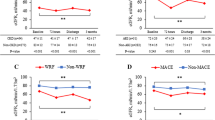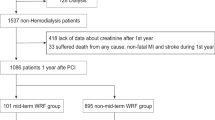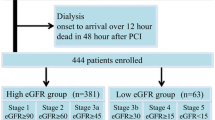Abstract
Acute kidney injury usually assessed within 48 h after percutaneous coronary intervention (PCI) is associated with poor clinical outcomes, and persistent kidney damage is also strongly related to long-term mortality. However, little is known about longitudinal renal function change from a very early period to long-term follow-up after PCI. A total of 327 patients with stable coronary artery disease underwent elective PCI. Renal function was assessed with serum creatinine levels and estimated glomerular filtration rate (eGFR) at baseline, 1 day after PCI, at 1 year and at the latest follow-up. Kidney injury was defined as an increase in creatinine levels ≥ 0.3 mg/dl or ≥ 50% from baseline at each timepoint. Major adverse cardiovascular events (MACE) was defined as a composite of death, myocardial infarction, and stroke. eGFR was significantly increased 1 day after PCI, while it was progressively decreased at 1-year and long-term follow-up (median 28 months). Overall, eGFR was declined by − 2.3 ml/min/1.73 m2 per year. Only one (0.3%) patient developed kidney injury 1 day after PCI, whereas kidney injury at 1-year and long-term follow-up was observed in 15 (4.6%) and 27 (8.3%). During the follow-up period, 23 (7.0%) patients had MACE. The incidence of subsequent MACE was significantly higher in patients with kidney injury at 1 year than those without. In conclusion, kidney injury within 24 h after elective PCI was rarely observed. eGFR was progressively decreased over time, and mid-term kidney injury at 1 year was associated with future MACE.


Similar content being viewed by others
References
Kidney Disease Improving Global Outcomes (KDIGO) (2012) Clinical practice guideline for acute kidney injury. Kidney Int Suppl 2:1–138
Mehran R, Dangas GD, Weisbord SD (2019) Contrast-associated acute kidney injury. N Engl J Med 380:2146–2155
Almendarez M, Gurm HS, Mariani J Jr, Montorfano M, Brilakis ES, Mehran R, Azzalini L (2019) Procedural strategies to reduce the incidence of contrast-induced acute kidney injury during percutaneous coronary intervention. JACC Cardiovasc Interv 12:1877–1888
Vanmassenhove J, Kielstein J, Jörres A, Biesen WV (2017) Management of patients at risk of acute kidney injury. Lancet 389:2139–2151
Seto AH, Shroff A, Abu-Fadel M, Blankenship JC, Boudoulas KD, Cigarroa JE, Dehmer GJ, Feldman DN, Kolansky DM, Lata K, Swaminathan RV, Rao SV (2018) Length of stay following percutaneous coronary intervention: an expert consensus document update from the society for cardiovascular angiography and interventions. Catheter Cardiovasc Interv 92:717–731
Abe M, Morimoto T, Nakagawa Y, Furukawa Y, Ono K, Kato T, Kadota K, Ando K, Ishii M, Masunaga N, Akao M, Kimura T (2017) Impact of transient or persistent contrast-induced nephropathy on long-term mortality after elective percutaneous coronary intervention. Am J Cardiol 120:2146–2153
Saito Y, Kobayashi Y, Fujii K, Sonoda S, Tsujita K, Hibi K, Morino Y, Okura H, Ikari Y, Honye J (2020) Clinical expert consensus document on standards for measurements and assessment of intravascular ultrasound from the Japanese Association of Cardiovascular Intervention and Therapeutics. Cardiovasc Interv Ther 35:1–12
Sonoda S, Hibi K, Okura H, Fujii K, Honda Y, Kobayashi Y (2020) Current clinical use of intravascular ultrasound imaging to guide percutaneous coronary interventions. Cardiovasc Interv Ther 35:30–36
Fujii K, Kubo T, Otake H, Nakazawa G, Sonoda S, Hibi K, Shinke T, Kobayashi Y, Ikari Y, Akasaka T (2020) Expert consensus statement for quantitative measurement and morphological assessment of optical coherence tomography. Cardiovasc Interv Ther 35:13–18
Horio M, Imai E, Yasuda Y, Watanabe T, Matsuo S (2010) Modification of the CKD epidemiology collaboration (CKD-EPI) equation for Japanese: accuracy and use for population estimates. Am J Kidney Dis 56:32–38
Isaka Y, Hayashi H, Aonuma K, Horio M, Terada Y, Doi K, Fujigaki Y, Yasuda H, Sato T, Fujikura T, Kuwatsuru R, Toei H, Murakami R, Saito Y, Hirayama A, Murohara T, Sato A, Ishii H, Takayama T, Watanabe M, Awai K, Oda S, Murakami T, Yagyu Y, Joki N, Komatsu Y, Miyauchi T, Ito Y, Miyazawa R, Kanno Y, Ogawa T, Hayashi H, Koshi E, Kosugi T, Yasuda Y, Japanese Society of Nephrology; Japan Radiological Society, Japanese Circulation Society Joint Working Group (2019) Guideline on the use of iodinated contrast media in patients with kidney disease 2018. Circ J 83:2572–2607
Thygesen K, Alpert JS, Jaffe AS, Simoons ML, Chaitman BR, White HD, Joint ESC/ACCF/AHA/WHF Task Force for the Universal Definition of Myocardial Infarction, Katus HA, Lindahl B, Morrow DA, Clemmensen PM, Johanson P, Hod H, Underwood R, Bax JJ, Bonow RO, Pinto F, Gibbons RJ, Fox KA, Atar D, Newby LK, Galvani M, Hamm CW, Uretsky BF, Steg PG, Wijns W, Bassand JP, Menasché P, Ravkilde J, Ohman EM, Antman EM, Wallentin LC, Armstrong PW, Simoons ML, Januzzi JL, Nieminen MS, Gheorghiade M, Filippatos G, Luepker RV, Fortmann SP, Rosamond WD, Levy D, Wood D, Smith SC, Hu D, Lopez-Sendon JL, Robertson RM, Weaver D, Tendera M, Bove AA, Parkhomenko AN, Vasilieva EJ, Mendis S (2012) Third universal definition of myocardial infarction. Circulation 126:2020–2035
Mehran R, Aymong ED, Nikolsky E, Lasic Z, Iakovou I, Fahy M, Mintz GS, Lansky AJ, Moses JW, Stone GW, Leon MB, Dangas G (2004) A simple risk score for prediction of contrast-induced nephropathy after percutaneous coronary intervention: development and initial validation. J Am Coll Cardiol 44:1393–1399
Bartholomew BA, Harjai KJ, Dukkipati S, Boura JA, Yerkey MW, Glazier S, Grines CL, O'Neill WW (2004) Impact of nephropathy after percutaneous coronary intervention and a method for risk stratification. Am J Cardiol 93:1515–1519
Tsai TT, Patel UD, Chang TI, Kennedy KF, Masoudi FA, Matheny ME, Kosiborod M, Amin AP, Weintraub WS, Curtis JP, Messenger JC, Rumsfeld JS, Spertus JA (2014) Validated contemporary risk model of acute kidney injury in patients undergoing percutaneous coronary interventions: insights from the National Cardiovascular Data Registry Cath-PCI Registry. J Am Heart Assoc 3:e001380
Watanabe M, Saito Y, Aonuma K, Hirayama A, Tamaki N, Tsutsui H, Murohara T, Ogawa H, Akasaka T, Yoshimura M, Sato A, Takayama T, Sakakibara M, Suzuki S, Ishigami K, Onoue K, CINC-J Study Investigators (2016) Prediction of contrast-induced nephropathy by the serum creatinine level on the day following cardiac catheterization. J Cardiol 68:412–418
Caspi O, Habib M, Cohen Y, Kerner A, Roguin A, Abergel E, Boulos M, Kapeliovich MR, Beyar R, Nikolsky E, Aronson D (2017) Acute kidney injury after primary angioplasty: is contrast-induced nephropathy the culprit? J Am Heart Assoc 6:e005715
Otsuka K, Shimada K, Katayama H, Nakamura H, Ishikawa H, Takeda H, Fujimoto K, Kasayuki N, Yoshiyama M (2019) Prognostic significance of renal dysfunction and its change pattern on outcomes in patients with acute coronary syndrome treated with emergent percutaneous coronary intervention. Heart Vessels 34:735–744
Liu Y, Duan CY, Wang K, Bei WJ, Guo XS, Li HL, Wang Y, Chen SQ, Xian Y, Chen PY, Geng QS, Tan N, Chen JY (2017) Could late measurement of serum creatinine be missed for patients without early increase in serum creatinine following coronary angiography? Medicine (Baltimore) 96:e8460
Ribichini F, Graziani M, Gambaro G, Pasoli P, Pighi M, Pesarini G, Abaterusso C, Yabarek T, Brunelleschi S, Rizzotti P, Lupo A, Vassanelli C (2010) Early creatinine shifts predict contrast-induced nephropathy and persistent renal damage after angiography. Am J Med 123:755–763
Chia YC, Lim HM, Ching SM (2016) Long-term visit-to-visit blood pressure variability and renal function decline in patients with hypertension over 15 years. J Am Heart Assoc 5:e003825
No authors listed (2013) Chapter 2: definition, identification, and prediction of CKD progression. Kidney Int Suppl 3:63–72
Nakahashi T, Tada H, Sakata K, Yakuta Y, Yoshida T, Tanaka Y, Nomura A, Terai H, Horita Y, Ikeda M, Namura M, Takamura M, Kawashiri MA (2020) Impact of concomitant peripheral artery disease on contrast-induced acute kidney injury and mortality in patients with acute coronary syndrome after percutaneous coronary intervention. Heart Vessels 35:1360–1367
Brugts JJ, Knetsch AM, Mattace-Raso FU, Hofman A, Witteman JC (2005) Renal function and risk of myocardial infarction in an elderly population: the Rotterdam Study. Arch Intern Med 165:2659–2665
Kurogi K, Ishii M, Sakamoto K, Komaki S, Marume K, Kusaka H, Yamamoto N, Arima Y, Yamamoto E, Kaikita K, Tsujita K (2019) Persistent renal dysfunction in patients undergoing primary percutaneous coronary intervention for acute myocardial infarction. J Am Heart Assoc 8:e014096
Katoh H, Nozue T, Horie K, Sozu T, Inoue N, Michishita I (2019) RenalGuard system to prevent contrast-induced acute kidney injury in Japanese patients with renal dysfunction; RESPECT KIDNEY study. Cardiovasc Interv Ther 34:105–112
Sakai K, Ikari Y, Nanasato M, Umetsu H, Okutsu M, Takikawa T, Sumitsuji S, Sadamatsu K, Takada M, Kato Y, Ogasawara N, Otowa K (2019) Impact of intravascular ultrasound-guided minimum-contrast coronary intervention on 1-year clinical outcomes in patients with stage 4 or 5 advanced chronic kidney disease. Cardiovasc Interv Ther 34:234–241
Coca SG (2013) Is it AKI or nonrecovery of renal function that is important for long-term outcomes? Clin J Am Soc Nephrol 8:173–176
Author information
Authors and Affiliations
Corresponding author
Ethics declarations
Conflict of interest
None.
Additional information
Publisher's Note
Springer Nature remains neutral with regard to jurisdictional claims in published maps and institutional affiliations.
Rights and permissions
About this article
Cite this article
Deguchi, Y., Saito, Y., Nakao, M. et al. Trajectory of renal function change and kidney injury after percutaneous coronary intervention in patients with stable coronary artery disease. Heart Vessels 36, 315–320 (2021). https://doi.org/10.1007/s00380-020-01701-1
Received:
Accepted:
Published:
Issue Date:
DOI: https://doi.org/10.1007/s00380-020-01701-1




